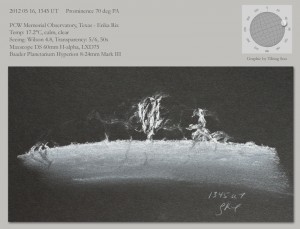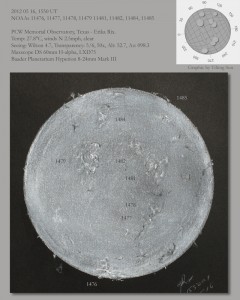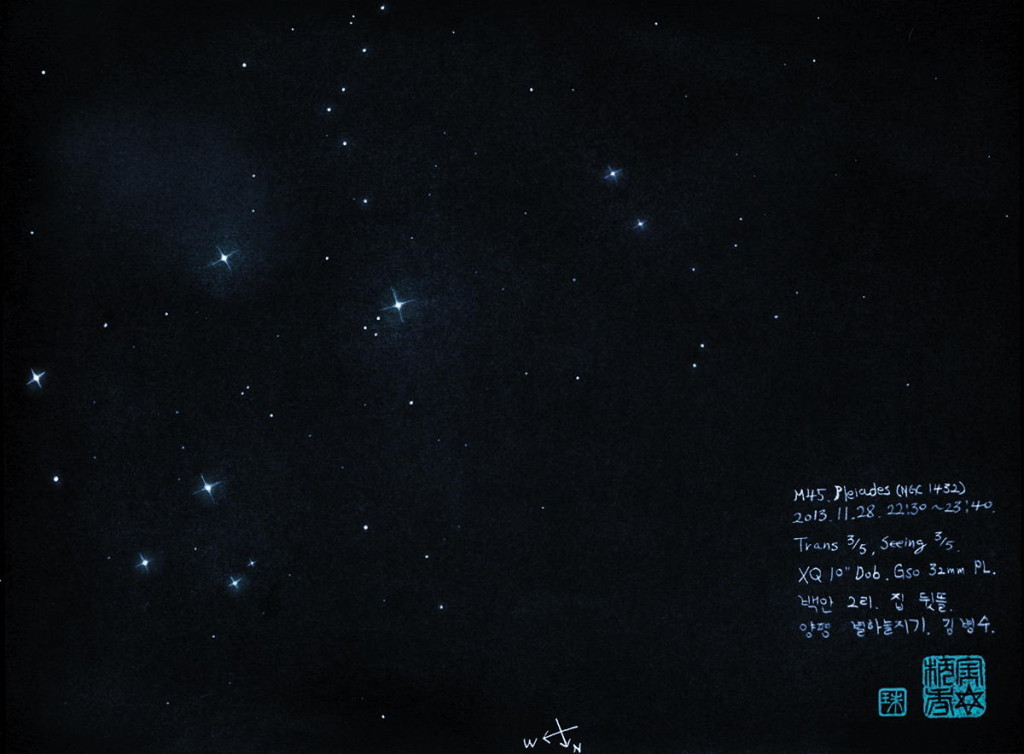
file name – “M45 Pleiades_kim byong su”
object Name – M45 Pleiades sketch
Location – Baegan-ri, Yangpyeong-eup, Yangpyeong-gun, Gyeonggi-do, South korea
Media – pencil, charcoal , white Paper
XQ 10″ Dob / GSO 32mm = “39x”
Charcoal pencil
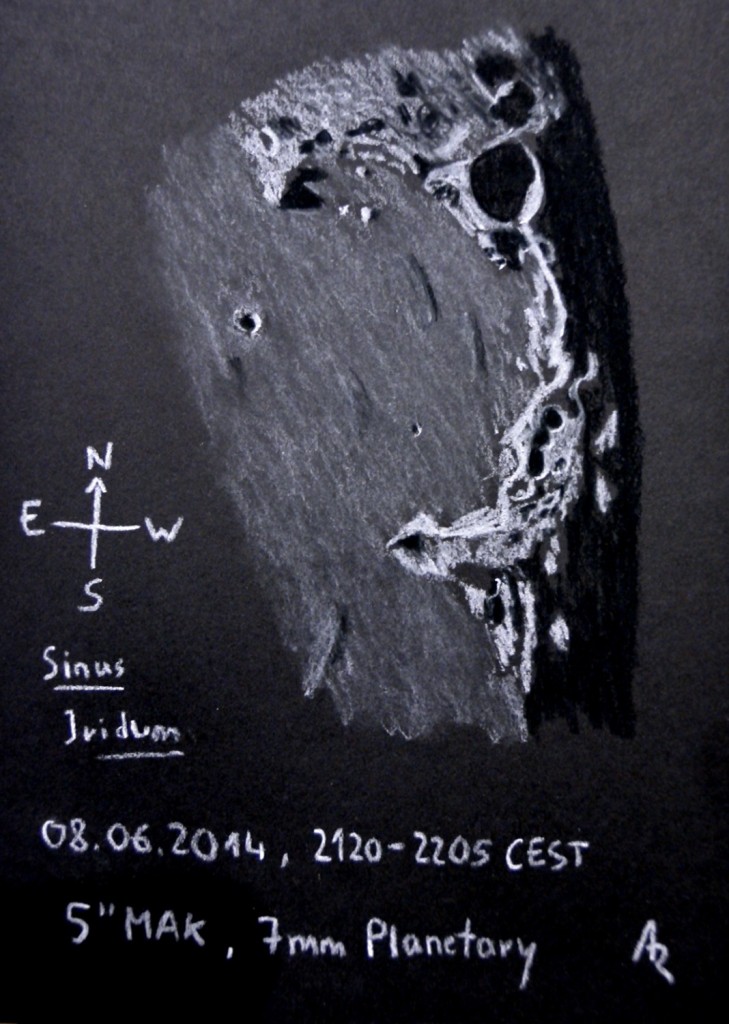
Find attached a sketch of Sinus Iridum with craters Bianchini, Laplace A, Laplace D and Heraclides E done yesterday evening.
Object Name Sinus Iridum, The Moon
Object Type Impact basin
Location Dusseldorf region, Germany
Date June 8th, 2014, 2120-2205 CEST
Media white pastel pen, charcoal pen on black cardbox paper
Telescope: Celestron Nexstar 127/1500 SLT
Eyepiece: TS HR Planetary 7mm
Best Regards,
Achim

I’ve been doing a study on lunar phases and this is my latest sketch. This is a photo of it from last night after wrapping up my observing session. No adjustments have been made to the sketch other than cropping the lower blank portion of the paper.
My phase sketches used to take close to two hours to complete at the eyepiece. I’ve been building up my endurance to 3-4 hours for a single sketch to include more detail. Obviously, the terminator is drawn first to “freeze” the time stamp on the phase. Then I work my way across the disk at a more leisurely pace, moving my observing chair and stool gradually as the session progresses.
I used a 102mm f/9.8 refractor on an LXD75 mount, 20mm eyepiece setting on my Hyperion zoom, and a 13% T Moon filter to help with contrast. The media is black Strathmore Artagain paper (60 lb., 160 g/m2), white charcoal pencil, black charcoal pencil, white Conte’ crayon, white Conte’ pastel pencil, black Conte’ color pencil,and a blending stump for the maria. I used a circular 6-inch protractor to outline the lunar disk.
Total eyepiece/sketch time is just over four hours on this one.
Best regards,
Erika Rix
www.pcwobservatory.com
Texas, USA

2012 01 07 – Mars
PCW Memorial Observatory, OH – Erika Rix
www.pcwobservatory.com
16” Zhumell, f/4.5, non-tracking Dobsonian mount
12mm WA Burgess, 2x Barlow, 300x magnification
Filters: Mars, 82A blue, 21 orange
5.6 C, 64% H, S: Pickering 4-5, T: 3/6
CM: 159.8°, Ls: 54°, Phase: 0.92, V. Mag: 0.1
RA: 11h 32m, Dec: 6° 18′ 51″
This was my most recent Mars observation from a few weeks ago. With only one or two clear nights since then, the timing was such that it prevented me from being able to crack open the observatory.
The early morning of the 7th, I had ample time to let the mirrors cool down on the telescope and collimated before dark. It was a little windy but had calmed down by 3am. Still, seeing wasn’t the best. I cold make out the NPC straight away and it appeared tucked in on the western and eastern edges more so than my observation the week prior. There was a definite dark streak above the NPC in my view and a few more darkened patches scattered around the disk. Very slight limb brightening on both the preceding (just prior to the terminator toward either pole) and following limbs.
I had to nudge the scope time and time again to let Mars slowly drift through my FOV before slight variances in albedo became apparent. It was nearly impossible for me to match them up with labeling programs such as Mars Previewer II or my Mars Globe app on my iPad because the two views on those programs were a little off from each other even though I checked the date, time and location several times. In the end, I went with Mars Previewer II since I’ve been using that program the longest.
I’m very much looking forward to more opportunities with Mars as it reaches opposition. If only my primary mirror was clean…sigh.
The sketch was created using charcoal on card stock, charcoal pencils, willow charcoal, vinyl eraser pencil and kneaded rubber eraser.
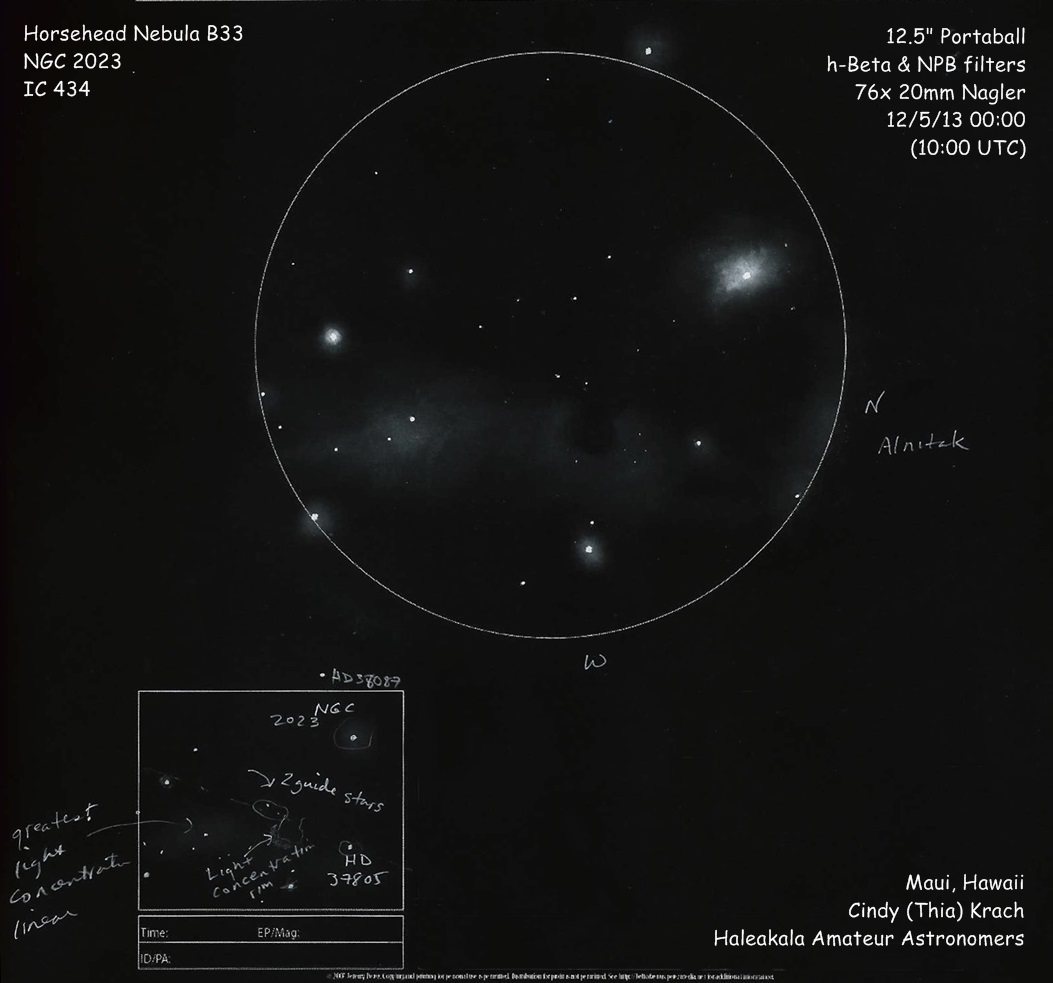
Aloha!
The evening of December 4th (morning of the 5th) was a beautiful night at one of my favorite spots 8 miles from my home on the road to Haleakala National Park. Very clear & very dark. I am finishing up my Planetary Nebula project with Astronomical League and at midnight decided to take a break & try for the Horsehead Nebula again while I was totally dark adapted. Last year I was elated to locate it from my driveway but didn’t sketch it at the time. This year I hoped from a darker location it would be even better, but I decided to just look and not get my hopes up.
After enjoying views of the Flame Nebula I placed Alnitak out of my field of view to the north. Using my 27mm & Narrow Pass Band filter I then placed NGC 2023 to the north inside my view and looked for the 2 – 10th & 13th magnitude guide stars to follow into the Horsehead.
I could see a dim dark patch with averted vision, hood over my head and an eyepatch on the opposite eye. After a short time I could make out the thumbprint of the head with some brightness around the rim and with longer observation a notch appeared to the NW. Some tiny stars also present themselves around the head as well as a linear brightness running N/S through IC 434. I then changed to a 20mm with h-beta filter and more light and dark details of IC 434 appeared, though overall it appeared darker. I got to work sketching & writing up details.
As I was finishing my sketch I heard a “whinnying” sound nearby. I froze because it sounded close and I was all alone. After a moment I realized its an app my daughter has on my iPad that makes horse sounds periodically. It just happened to do so while I was observing the “Horse”! I giggled and ended the night there. What could top that!
B33, IC 434, NGC 2023
Dark Nebula, Emission Nebula, Reflection Nebula
Haleakala Highway 6,000 ft el, Maui, Hawaii
12/5/13 12:00pm, 10:00 UTC
12.5” Portaball, h-Beta & NPB filters, 20mm 76x
Charcoal pencil, charcoal with brush technique, white paper
Inverted with Photoscape software
Cindy (Thia) Krach
Haleakala Amateur Astronomers

On Friday evening after setting up to observe, I could see sky conditions would be better than average for this time of year( late fall).
When Jupiter climbed to more than 60 degrees above the horizon, I realized that this would be the night to make a first sketch of Jupiter for the season.
The GRS was redder than last season especially in its center and was well set apart from both the South Tropical Zone and South Equatorial Belt. Europa had just emerged from behind the North Tropical Zone on the following side of the planet. A couple of festoons could be clearly seen in the Equatorial Zone emerging from the North Equatorial Belt.
It was right at my tolerable cold temperature limit for sketching and I finished before needing to retreat indoors to warm up.
On a steady night of good seeing this is the time to give Jupiter a look.
Equipment Used: 13.1 inch f/6 Dobsonian running on an equatorial platform 6mm eyepiece (333x) and Baader Neodymium filter
Sketching: Assorted graphite pencils, medium hard charcoal pencils, erasers, blending stumps,
white copy paper
Seeing: Pickering 7/10
Transparency : Average 3/5
Temperature: 21°F (-6°C)
Jupiter: Visual mag. -2.6, Diameter 44.65 “, illumination 99.6%, distance from earth 4.4 au
Frank McCabe
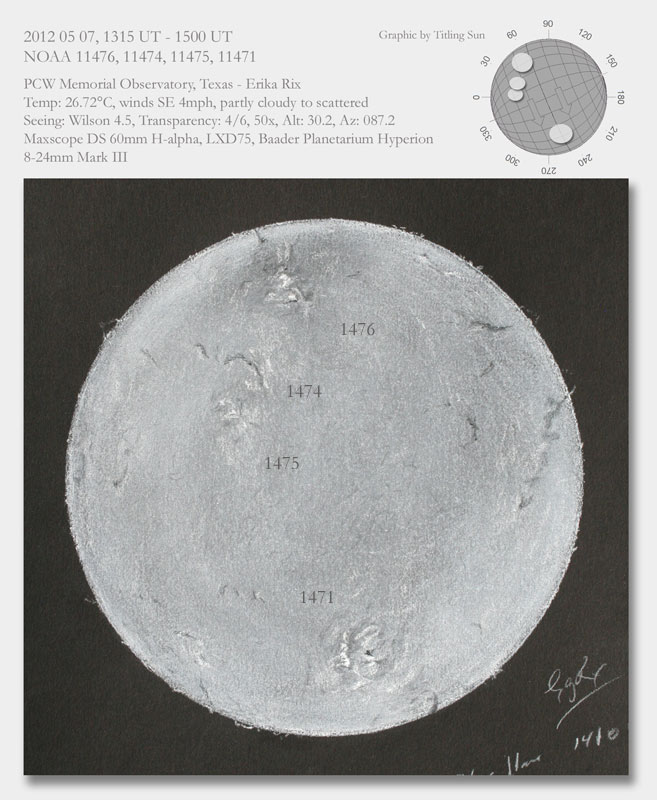
2012 05 07, 1315 UT – 1500 UT.
NOAA 11476, 11474, 11475, 11471.
PCW Memorial Observatory, Texas – Erika Rix
www.pcwobservatory.com
Temp: 26.72°C, winds SE 4mph, partly cloudy to scattered.
Seeing: Wilson 4.5, Transparency: 4/6, 50x, Alt: 30.2, Az: 087.2.
Maxscope DS 60mm H-alpha, LXD75, Baader Planetarium Hyperion 8-24mm Mark III.
Sketches created at the eyepiece with black Strathmore Artagain paper, white Conte’ crayon and pencil, white Prang color pencil, Derwent charcoal pencil, black oil pencil.
I’ve really been enjoying the current set of active regions the past few days. It would be nice to sketch each individual active region as a close up view, but to do that would take several hours. As it was today, I struggled with a group of thick clouds for the first hour of my session. The sky was crystal clear when I set up and I chose to ignore the weather channel for my area stating that we could have thunderstorms at 8 a.m. Thankfully the storms never came…the clouds did. I was able to catch glimpses of the Sun in between the clouds and by 8:45 a.m., the sky was nearly unobstructed.
The first features added to the sketch after the prominences were plage from 1476 and 1471. Next came the sunspots themselves and filamentary structure. By 9:10 a.m. (1410 UT), very bright plage appeared just north of the sunspots in 1471. I haven’t been able to confirm yet if it was a solar flare, having expected possible flare activity in 1476 instead. But it lasted nearly an hour before it dulled somewhat. Near the end of my session, 1471’s plage brightened quite a bit to the eastern side of the major sunspot in that region as well as about five more degrees further east again.
1474 and 1475 paled in comparison to the two major active regions. There were nice filaments and thin plage that made them easy to find.
The large chain of filament reaching to the southern limb was still there, although thinner. Prominences scattered around the limb were insignificant.
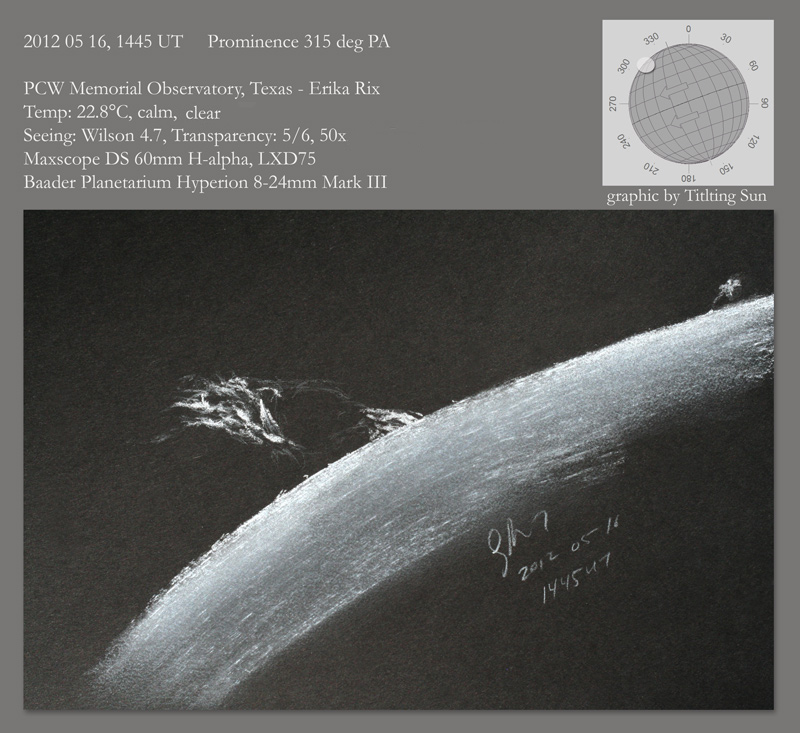
2012 05 16, 1300 – 1600 UT .
NOAAs 11476, 11477, 11478, 11479, 11481, 11482, 11484, 11485.
PCW Memorial Observatory, Texas – Erika Rix
www.pcwobservatory.com
Temp: 17.2°-27.8C, calm-N 5mph, clear.
Seeing: Wilson 4.8-4.6, Transparency: 5/6, 50x.
Maxscope DS 60mm H-alpha, LXD75, Baader Planetarium Hyperion 8-24mm Mark III.
Sketches created at the eyepiece with black Strathmore Artagain paper, white Conte’ crayon and pencil, white Prang color pencil, Derwent charcoal pencil, black oil pencil.
As of this morning, there were 8 active regions on the Sun. Plage and filaments scattered over three quarters of the solar disk with sunspots popping in and out of view crisply as it moved in and out of the scope’s sweet spot. A large diffuse quiet region filament, similar to the one observed on May 6, 2012, was to the SE quadrant reaching out over the limb. Two large bright prominences were located at PA 70 and 115 with several smaller ones scattered around the limb. The prom at 70 degrees had very faint wisps of structure reaching between the three brightest regions.
I had started to draw the full solar disk when a faint pair of prominences to the NW caught my eye. I had accidentally kicked the adaptor that was plugged into my power pack and the mount turned off, allowing the disk to drift across my field of view. When this happened, a huge billow of plasma floated above the limb. It was attached by very slender lines of plasma to the thick fainter prom at the 315 degrees position angle. It had the appearance of a large balloon being blown to the south while tethered to the ground. Tossing my larger sketchpad to the side, I grabbed the smaller pad and quickly sketched this prom. As the course this morning’s observation went on, the billowed top of the prominence changed quite dramatically. I almost expected it to either break free or collapse on itself before my session ended but by the time I completed the full disk sketch, it was still there.
The prominences near 1476 were dense and compact. The plage was very brightly formed as several slender lines within that active region. The main sunspot in 1476 was very easy to spot in h-alpha although the ARFs were very thin and few.
1479 is reminiscent of 1476 several days ago, although the preceding spot standing alone is on the opposite end. Of course, another difference that the sunspots in 1479 are smaller. They may develop more as the days go on. Here’s hoping for beautiful weather so we can keep an eye on it.
